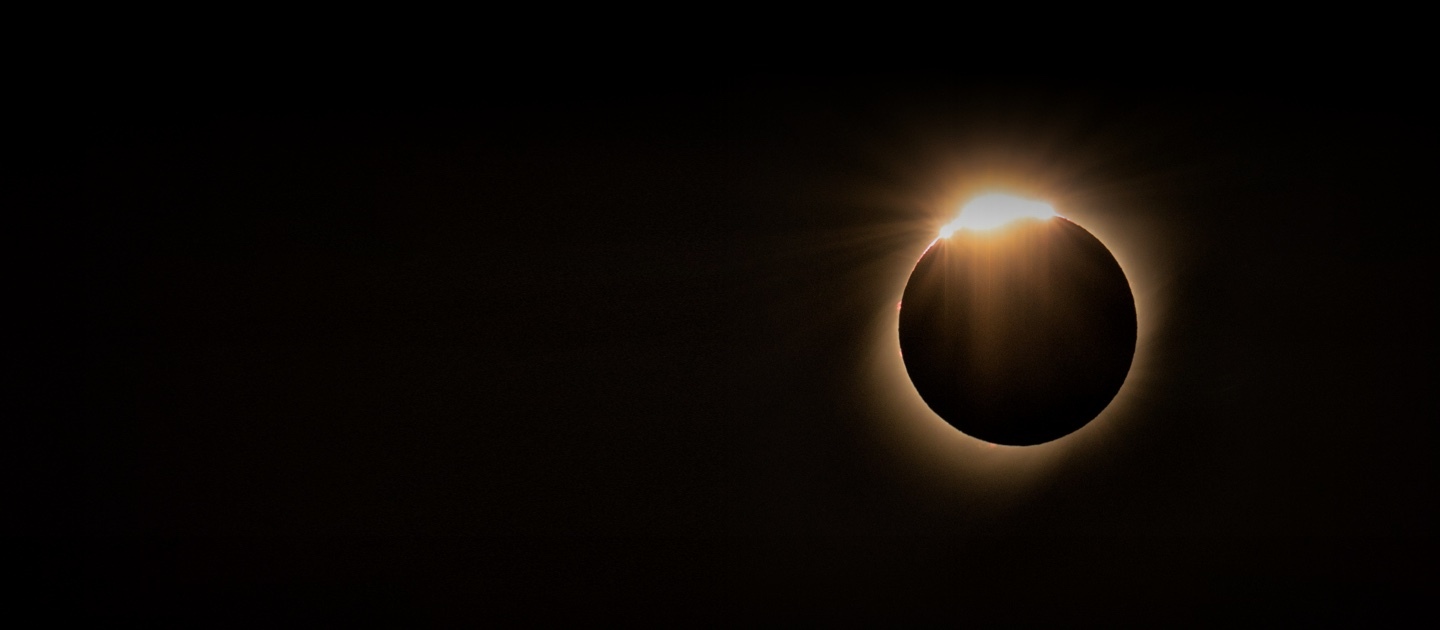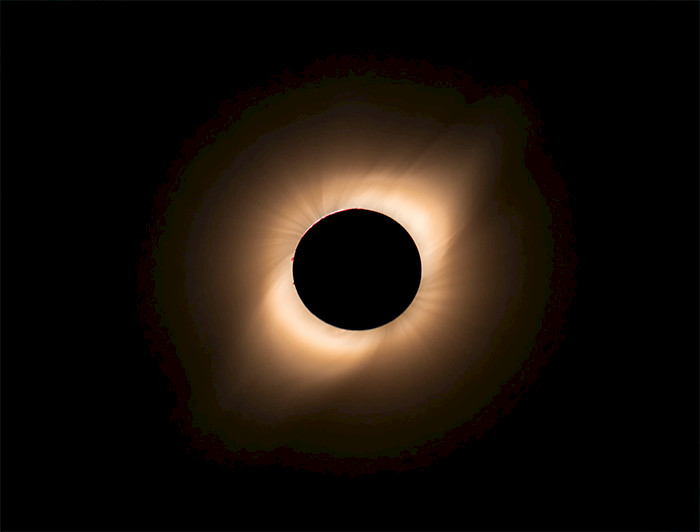
Why solar eclipses are important to science?
Araucanía will be the scenery of one of the most captivating Astronomy events: an eclipse. For two minutes, the sky will darken completely, revealing only a luminous circle of light around the Sun. Why is this important?

photo_camera UC invites you to follow the total solar eclipse on December 14 in Araucanía through its different signals. (Credit: Francisco Gamboa)
On May 29, 1919, occurred an essential total solar eclipse for science. The British astronomer Arthur Eddington was able to verify that the light of distant stars bends when passing next to the Sun. With this experiment, he could demonstrate nothing less than Albert Einstein's Theory of General Relativity.
The German physicist claimed that a body mass, like the Sun, deforms the space-time around it. Other bodies, such as planets, move around it following trajectories in that curved space. A ray of light also moves in a curved space, deviating its course, and is no longer a straight line. In other words, light is deflected by an object's gravity with a lot of mass, such as the Sun.
This observation, made more than a century ago, will be repeated in the total eclipse of this December 14 in Araucanía.
Astronomers from de UC Institute of Astrophysics will be capturing high-resolution images. Through powerful telescopes and first-rate equipment, they will be recording the event at 1,400 meters high, at the slopes of Villarrica volcano.
The eclipse will begin at 11:41 a.m., to reach the peak of totality at 1:03 p.m., with the Sun located at the height of more than 70 degrees above the horizon.
The Sun height marks a difference with the 2019 eclipse in Coquimbo, which occurred during the afternoon when the star was lower on the horizon and, therefore, more tenuous.
"The effects, such as the cooling of the atmosphere and the surrounding light, will differ markedly in this eclipse," says the initiative's leader, Thomas Puzia, a scholar at the Institute for Astrophysics.
The celestial dome will be seen more clearly, including the Sun's corona, whose dim brightness is more difficult to appreciate in everyday situations.
Another unique condition will be that the eclipse will happen with the Milky Way center as a backdrop. "We could watch our Solar System, which is spectacular, and we are going to see four planets: Venus, Mercury, Jupiter, and Saturn," says the astronomer.
"We also expect Comet Erasmus (C / 2020 S3) to become bright enough to be visible between Mercury and Venus during the total eclipse. The comet visits us every 2000 years in the inner solar system. Also, the Geminid meteor shower will peak the night before, so there is a good chance that a shooting star will appear during the 2 minutes and 9 seconds of total darkness. We are going to have a three-dimensional perspective of our solar system", he concludes.
This opportunity will undoubtedly be unique.
The next eclipse will be in Antarctica on December 4, 2021. "There, the sun looks very low on the horizon so that it will be dimmer, although the band of tonality is going to be wider," explains Puzia.
A natural laboratory
The data obtained during the eclipse will be an essential contribution to the scientific community, positioning the Institute as a benchmark.
"Eclipses are phenomena of high impact in the community. They also allow us, as scientists, to do research that otherwise would not be possible," says the director of the Institute of Astrophysics, Felipe Barrientos.
One of the main tasks will be obtaining high-resolution images of the solar corona. "The corona is the link between the Sun and space, or the solar system," says Thomas Puzia.
Astronomers are not yet sure how energy transport occurs between the Sun's surface that we see (photosphere), the thin layer of its atmosphere (chromosphere), and the corona.
"The photosphere has a temperature close to 6,000 degrees Kelvin. It has a much higher density and disperses into space. Still, in this process, the temperature of the particles increases greatly. The corona - the outermost part of the solar atmosphere - is one million kelvin. It is not yet clear how this increase in temperature works", explains the astronomer.
The corona study allows us to understand and model the Sun's surface activity. "The high-resolution images allow us to confront the models that explain their behavior with reality," adds Puzia.
The ways to watch the eclipse
The eclipse can be seen throughout Chile, in varying degrees of partiality. In Santiago, it will be 78%. However, Universidad Católica will be broadcasting live from Araucanía so that all people can appreciate it even with the pandemic restrictions.
The Institute of Astrophysics will carry out three types of transmissions:
- The first will consist of the eclipse itself. A telescope and a high-powered lens will capture the images shared with the United States Space Agency, NASA, and broadcast through NASA TV. They will also be seen through Marca Chile, San Francisco Exploratorium, and Carnegie Institution for Science, among others. In addition to Pucón TV, the network of regional channels Arcatel and Media UC. The event also has the collaboration of the Pucón Municipality.
- The second transmission will take place through the YouTube channel of the UC Institute of Astrophysics. The eclipse broadcast will be going on with interviews with national and international experts who will explain the phenomenon in both English and Spanish.
- The third will be a sonification of the eclipse. Through unique technology, photons' flow will be converted into a frequency to allow blind people to experience the eclipse's sensation. "The Institute of Astrophysics is part of the Inclusive Astronomy organization, which brings together several institutions at a national level. In 2019, sound systems were used in the Coquimbo eclipse with people with visual disabilities. It worked very well, and this year these devices were created here in Chile", says Daniela Fernández, an intern astronomer at the UC Teaching Observatory.
All this work is added to the Institute's high-level scientific dissemination activities through its series "Golden Webinars in Astrophysics." By free and online conferences, leading figures in world astronomy have addressed topics such as the expanding universe and the formation of galaxies or big data.
"This has put us in a prominent place in Latin America, boosting the interest of international graduate students who want to come to study with us. And has increased collaborations with institutions from different parts of the world," says Felipe Barrientos.
On Monday, December 14, UC Villarrica Campus, located in the middle of the eclipse zone, will present an online eclipse program (in Spanish) on UC Youtube Channel. There will be a conversation about Mapuche's worldview on the eclipse, astronomical aspects, and the effects on the environment and tourism.


